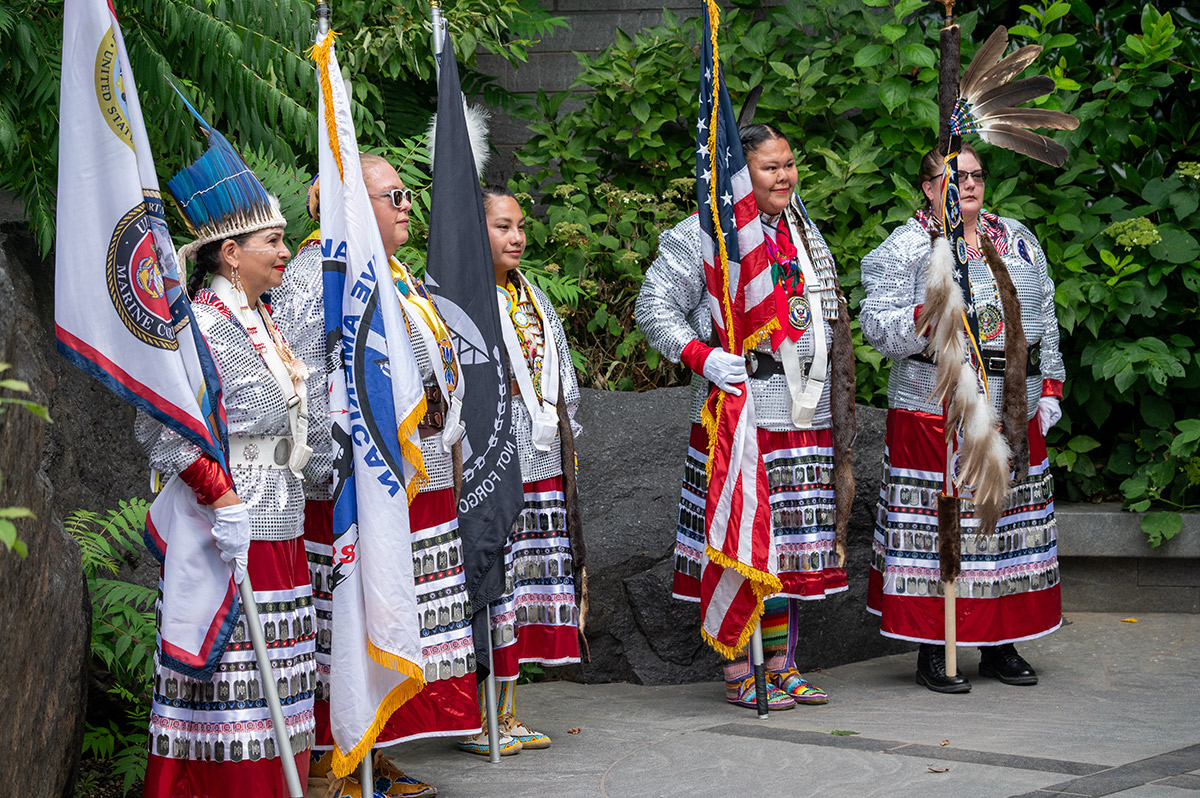Cameras: Ali Ali, David Barnes, Trinity Le
Editor: Ali Ali
Members of the Native American Women Warriors, the first all-female Native American color guard in the country, stand proudly in jingle dresses, each holding a flag. The first woman in line carries an eagle staff adorned with feathers from this sacred bird and stars from decommissioned American flags. The other women display flags that honor all individuals who have served in the U.S. military, including those who are missing in action or prisoners of war, along with one commemorating their own group of Native women.
Their silver tops shimmer in the bright sunlight, highlighting the emblem worn above their hearts, which pays tribute to their fallen sister, Specialist Lori Piestewa, the first Native American woman to lose her life while serving in the U.S. military. Their skirts, adorned with dog tags, emit a soothing jingle as they move, symbolizing healing for the veterans they represent. Each of the five women showcases elements of traditional regalia that reflect their unique homelands.
In the background, a deep male voice echoes alongside the rhythmic beats of a drum. As he sings, the women march in unison towards the National Native American Veterans Memorial.
Warriors, Yet Patriots
For many, this coexistence of American patriotism and Indigenous pride can appear contradictory.
“We often receive inquiries about how we can carry an American flag when our lands were taken from us,” shares Natalie Holt Breen (Abenaki), a board member of the Native American Women Warriors and participant in the Folklife Festival. “The flag symbolizes the people. We take pride in serving to uphold the strength of our people, transcending our individual tribes.”
Holt Breen emphasizes that, within Native American culture, being a warrior is regarded as the highest honor. United in their commitment to service, the nonprofit NAWW acts as a global support network for Native American women veterans, embodying the service ethos that has been upheld across generations.

Photo by Sonya Pencheva, Ralph Rinzler Folklife Archives
Among all ethnic groups, Native Americans possess the highest rate of military service per capita, with women constituting twenty percent of those serving.
Historically, a “warrior” might be envisioned as a Native person defending their tribe. Nowadays, it could refer to an individual serving in the U.S. military. Holt Breen explains that a warrior broadly encompasses “someone who safeguards our culture, traditions, supports our youth, assists families, and benefits the community.”
“Protecting something isn’t limited to one aspect,” notes NAWW secretary Inez Sanchezolmos (Northern Arapaho). “It can encompass an idea, people, or the future.” This understanding is becoming increasingly prevalent among younger generations.
When Sanchezolmos enlisted in 2002, she encountered resistance from her Arapaho family, who held deep-seated beliefs about the government’s integrity. “After the September 11 attacks, however, my perspective shifted. It was driven by a sense of patriotism—it became a collective ‘us’ as Americans confronting a shared challenge,” she reflects.
Connecting Culture and Honoring Legacy
NAWW combats the erasure of Native American identity by linking younger generations to their rich history of service. Through genealogical research and family history books, Holt Breen traces her family’s military roots back to 1250.
Her lineage is varied, comprising English, German, Finnish, Abenaki, and Penobscot heritage, with warriors present in each branch. Notably, her great-grandfather served in the French and Indian War (1754–1763), a conflict that saw Native warriors align with colonial powers offering the most security on the battlefields.
While Native Americans have served honorably in numerous wars, their contributions often remain unacknowledged. Historical records suggest that Haudenosaunee women fought valiantly in the War of 1812, yet their roles were often minimized to supporting duties. The Navajo Code Talkers utilized their language as an unbreakable code during WWII, while Iroquois nurses served on the front lines during WWI and documented their experiences in writing.
With the mission to “honor Native women who have served from the beginning,” as Holt Breen states, NAWW amplifies the visibility of Native warriors within American military history and helps reconnect individuals to their heritage and culture through a united, intertribal network of warriors. Holt Breen reflects that relocating frequently as a child of military parents can lead to a disconnection from one’s cultural identity.

Photo by Julie Byrne, Ralph Rinzler Folklife Archives
Selisha Lossing (Paiute), a member of the NAWW color guard, expresses that she felt disconnected from her culture during her upbringing in foster care.
“My cultural identity was overshadowed by the trauma and challenges my family faced due to alcoholism,” she reflects. “NAWW holds significance in my life because it helped merge my military experience and personal identity.”
Though she wishes she could have served longer, Lossing received an early medical discharge due to sexual trauma she endured in the military. Through NAWW, she shares her journey, finds healing, and supports other women in vocalizing their experiences. “With every story I share, I heal a bit more,” she shares.
A Sisterhood of Service
“There’s a unique soul-filling energy when women unite,” states Holt Breen. “But when Native women gather, it’s an empowering experience that nurtures your spirit.”
The women of NAWW joyfully refer to their organization as a sisterhood. Nieva Maria Santana Brock (Taíno), a retired Navy JAG officer, has discovered solace within NAWW: “I’ve finally found a sisterhood where I can honor our ancestors together.”
NAWW offers resources for veterans seeking support during their transition to civilian life, aid in recovering from PTSD, and assistance in emergency situations. “We extend our support to all veterans, not exclusively women nor limited to Native Americans,” Holt Breen emphasizes. While support is inclusive, it remains crucial to recognize that NAWW was founded by and for Native women.
Throughout military service, individuals may encounter a diverse environment, but the connection with other Native American women brings a distinctive resonance, Sanchezolmos observes. “It’s magnetic,” she describes.
Recollecting her friendship with a fellow sailor in the Navy, she notes, “We discovered each other’s beaded keychains and began talking. It felt like an instant connection. We remain deeply bonded today, sharing our cultural heritage both in and out of service.”
NAWW also fosters connections among Native women through shared cultural experiences, both during and after their time in service.

Photo by Sonia Pencheva, Ralph Rinzler Folklife Archives
Bringing in the Flags
When Mitchelene Big Man (Apsáalooke/Hidatsa) founded NAWW and established its color guard in 2010, she provided Native women with their own platform to stand in ceremonies honoring veterans— a significant milestone since they had previously been included in mixed color guard groups without receiving due recognition.
“Before 2010, the representation of women veterans was minimal,” Sanchezolmos reflects. “My sister and I, both veterans, have often found ourselves sidelined. With the establishment of an all-female color guard, we finally had our moment in the spotlight. Things are evolving— I’m now asked to carry in the flags.”
Since its inception, NAWW has participated in two presidential inaugurations, contributed its ceremonial regalia to the National Museum of the American Indian, and honored veterans at the 2024 Smithsonian Folklife Festival.
“We represent our collective people: the citizens of the United States and our tribes,” asserts Holt Breen. “If we don’t share, showcase, and pass down that knowledge, it risks being lost.”
Through the establishment of NAWW and its pioneering color guard, the contributions of Native Americans, and indeed all of the United States, can better recognize the significant roles they have played in serving their country and safeguarding their lands as descendants of the first inhabitants.
“It’s more than merely carrying flags,” Sanchezolmos emphasizes. “It’s about the acknowledgment of our service.”

Photo by Stanley Turk, Ralph Rinzler Folklife Archives
Naomi Skiles is a writing intern at the Smithsonian Center for Folklife and Cultural Heritage. She is a senior at American University studying anthropology and creative writing and is passionate about human connection both in her studies and beyond.




